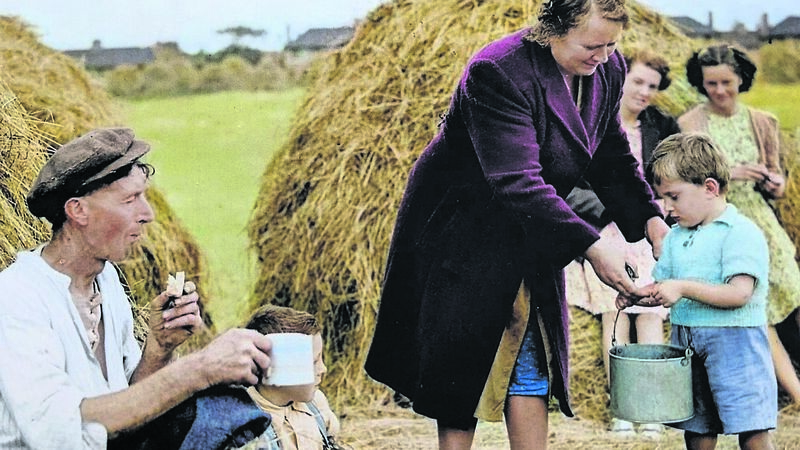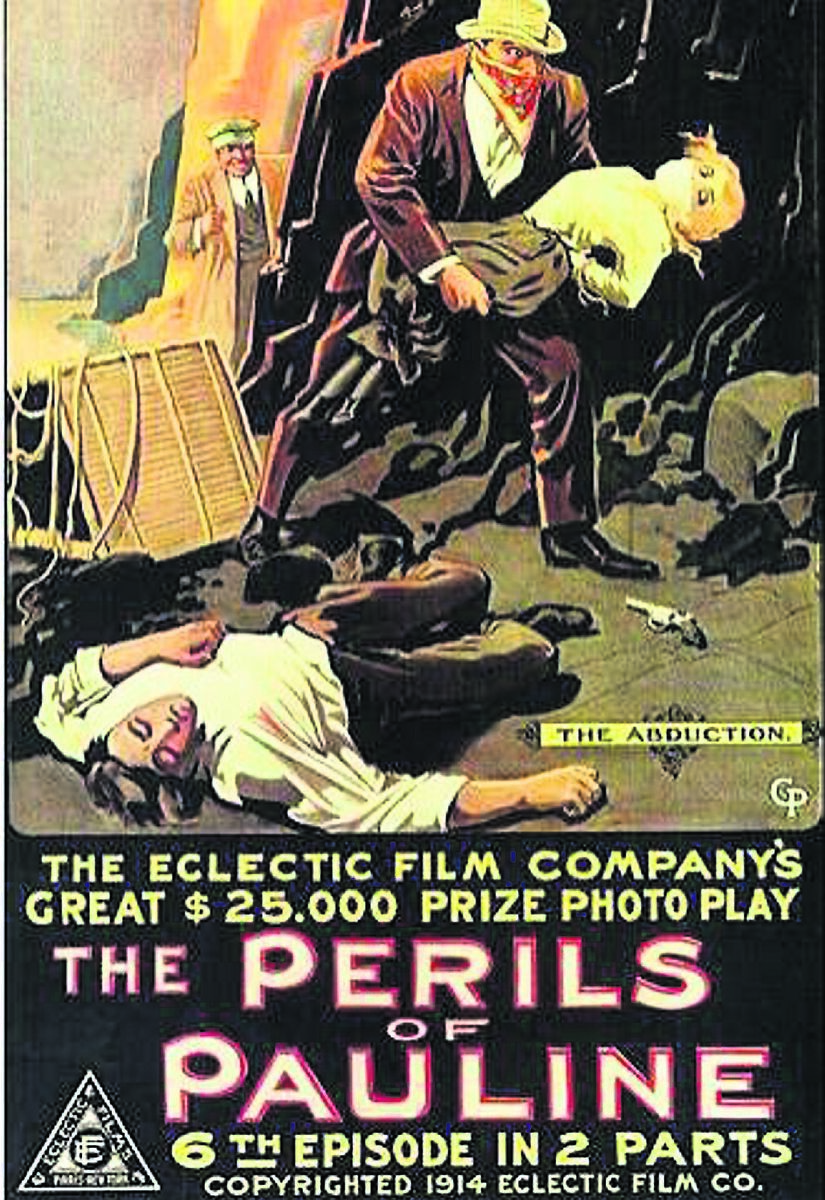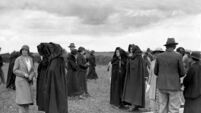Is there a railway link under Cork barracks?

The photo on the cover of the book Old Ireland In Colour 3, showing people in Wilton in 1947. Can anyone identify these people?
THROWBACK Thursday reader Finbar Bevan has raised a fascinating question about the old days of cinema-going, and in particular the film genre known as ‘cliffhangers’, where you had to come back the following week to see what happened at the critical moment. (Much like a TV episode of a popular soap opera today).
“Your Throwback on a Thursday is very good,” writes Finbar. “My story is, I was born in 1944 on Kilnap Green, as part of a large family (12 children!), and believe me, money was very short.
“The hub of our outlook for enjoyment was the famous cinema in Blackpool, the Lido. As I said, money was in fierce short supply, but we were enterprising young lads in the 1950s on how to get money to get there.
“You see, a lot of factories had their own dumps, the likes of the Sunbeam, Harringtons, and others, so about six of us would go to them to look for jam jars.
“We would clean them in the local river, and then, when we had enough of them, we would take them to Ogilvie and Moore in Parnell Place and receive tuppence for a two pounder, and a penny for a one pounder.
“As we could have a dozen of the jars, we had enough money to go to the Lido that night.”

And they did get value for money back then, says Finbar, with a programme that was positively crammed with good things.
“The show would start with cartoons, ‘Yee, what’s up, Doc?’ then maybe The Three Stooges, followed by the main film, something like Tarzan, and finally, what we went to all our trouble for, the ‘following-up one’.”
Finbar explains what this was.
“You know - from last week the stage coach would be heading for the cliffs, the boy [the good fellow] and the bad man would be fighting on top of the coach as the horses would be galloping all the time towards the cliff edge, but as always, the boy won, the stage coach was saved, and he won the girl as well, and the bad man was knocked out.
“Phew, so we must start to get more money somewhere for next week again, more brain work, but it seemed we always did somehow get money for next week’s show.”
Did Finbar know the lively Willie O’Sullivan, we wondered, who has featured on the pages of Throwback Thursday recently with his moneymaking efforts? Willie lived on Kilnap Place, and Finbar on Kilnap Green, so surely they did?
“Of course I remember Willie! He was as hard a worker as the rest of us at raising money to go to The Lido or buy sweets.
“You see, Jo, trying to get money that time was pretty hard, especially to get to the Lido for, most of all, those, ‘following up shows’.
“We had other ways to get money too for the Lido cinema in the 1950s, but that’s another story if you want to hear about it some time.”
Oh, we do, Finbar, we do! Tell us all you can remember. You never know who else will read it (as Throwback Thursday now has thousands of followers) and find their own memories of childhood days in Cork returning vividly. So send us any more recollections you can.
The following-up shows or, as they were known in cinematic circles, ‘the cliffhangers’, were a feature of early cinema, being in short episodes (a big bonus when film was in its infancy) and thus relatively inexpensive to produce.
This writer’s mother remembered them very well from her own childhood, but that would have been back in the early or mid 1920s, when film had yet to acquire sound, or indeed colour. The Jazz Singer in 1927 was probably the first to introduce short song sequences, but anything like the smooth sound to which we are accustomed today was still in the future.
Those 1920s audiences had instead a lively tinkling accompaniment from an experienced pianist who, glancing up at the screen, could see a romantic moment or a thrilling escapade coming, and rapidly adjust the notes and themes to match.
“There was great excitement in those cliffhangers,” my mother often reminisced fondly. “The heroine would be tied to the track with the train roaring up, or the stage coach was almost at the cliff edge, and then the film finished!
“Of course, we rushed back the following week, but somehow the train was further away than the previous instalment, and the hero was able to get there in time, and the stage coach was well back from the cliff. But we loved them!”
Classics of the cliffhanger genre were series like The Perils Of Pauline, first produced by William Randolph Hearst in 1914. It had 20 episodes, varying in length from 20 to 30 minutes, and was an instant success, being shown continuously right into the 1920s.
By the 1930s, Rin Tin Tin was a canine star of the Western adventure series The Lightning Warrior (it ran to 12 episodes) while Buck Jones, Gene Autry, and Tom Mix also shot to fame.
Audiences of the 1940s were enthralled by Captain Marvel, Holt of the Secret Service, Dick Tracy, and King of the Texas Rangers, among many others.
And yes, the series were being produced right into the 1950s, where Finbar Bevan remembers them so fondly.
Cody of the Pony Express, Buffalo Bill, Captain Kidd, King of the Congo, Son of Geronimo - all in 12 or 15 part series - spread out over several joyful weeks for young Cork cinema-goers who could find enough jam pots for entry to the Lido.
It does look (although we would love to be shown differently) as though Cork’s bigger cinemas had dropped the cliffhangers a lot earlier than the beloved old Lido, which knew very well the real attraction to their largely juvenile audiences, and kept the old footage running until it fell to pieces.

By the 1960s, modern cinema had eschewed this old-fashioned format, and instead a typical programme at, say, The Savoy, would include a stand-alone Scotland Yard thriller or a Disney nature feature, as well as the main attraction.
Did The Lido still show cliffhangers in the 1960s? We would be very interested to hear from anyone else who remembers seeing these thrilling weekly episodes in childhood, and if they saw them anywhere but at the Lido. Or indeed if your parents ever spoke of them. Do please tell us.
Now - some identification required please from eagle-eyed readers! Mary Holly has sent us the cover picture from that delightful book Old Ireland In Colour, by John Breslin and Sarah-Anne Buckley.
“I got a present of this book for Christmas,” said Mary. “The photo was taken at Wilton in 1947. Surely someone would know who these people are?”
Mary really wants to know, as this is right in the time of her own Wilton childhood, when open fields and lanes were all around instead of packed housing estates.
So look at that wonderful picture in a hayfield of yesteryear and give us your best guess. The busy housewife bringing out the billycan of tea? That exhausted workman leaning against the rick? The girl helpers, the children?
Mike English, are you reading this? You are a treasure chest of recollections on yesteryear in the general Bishopstown area!
We recently ran some of the best-read Throwback Thursdays of 2023 online at EchoLive.ie, and Mick McSweeney wrote to say: “Great piece on the abandoned tunnels around Cork (March 9, 2023), and also your mention of that famous old pub, The Grand Circle, down at the other end of Emmet Place from the Opera House.
“My late father and sister both worked in the Grand Circle back in the early 1970s. A great pub, one of the few Guinness houses back in the day.”
Mike continued: “We lived in married quarters in Collins Barracks in the ’50/’60s, and apparently there was a tunnel under the Barracks which was a branch off the tunnel from Kent Station to Blackpool.
“The Kent/Blackpool tunnel runs beneath Collins Barracks, and you can still see the steam/smoke vent behind the buildings opposite the top gate.
“Rumour has it that this was for bringing in arms and ammunition from the quays to the then Victoria Barracks.
“We, as kids, used to play around the military church, and there was an abandoned hole heavily covered with steel bars nearby. We called it ‘The Devil’s Hole’, but I wonder if there was any truth as to the tunnel story?”
Well, once again we call on readers to share their own recollections of folklore, legend, and even factual truth! As soon as we have it, we will tell you, Mick!
Pat O’Mahony has also written to tell us how much he enjoyed reading that Throwback Thursday article on tunnels, wherein were featured the recollections of Pat Kelly, who knows so much about old Cork.
“The mention of Pat Kelly’s name brought back fond memories of walking the streets of the city with him, and the wealth of historical knowledge he has,” said Pat.
“I remember as a child, some time around 1966 to 1969, using an old Holly Bough to do a project on Cork. It had some of the most amazing reproduction drawings of our city from back in the day when sailing ships docked on the Grand Parade, the Coal Quay, and in Patrick Street.”
There is so much history in plain sight that we walk past, observes Pat, and never notice.
“A classic example of this is what appears to be a steel bollard , embedded into the footpath, on the corner of Tuckey street and the Grand Parade.
“Most Corkonians, if they notice it at all, think it was a bollard for tying up ships. But were one to stand behind it, and feel around some 6 or 8 inches from the top, there is a hole one can place their little finger into.
“This is in fact one of the cannons from The Siege of Cork in 1690, and that aperture is the touch hole for firing the gun.
“For many years, I have wondered why one of the flagstones on the street beside it does not have a brass slab of some description telling its history. Surely it deserves that much?”
Another historic spot, says Pat, is the laneway just down from the Fountain, at the top of Oliver Plunkett Street. This is Grafton Lane.
“While we certainly have a Grafton Street in Dublin, it was in this very laneway, towards the South Mall end, that the Lord Grafton of the day was killed by a French sniper. This fascinating snippet of history was imparted to me by Pat Kelly as we strolled by one day. What a great body of knowledge he carries!”
On the topic of tunnels, Mr O’Mahony remembers hearing of some kind of an underground route that ran from North Presentation on St Mary’s road, back in the days when there was also a laundry there.
“Where it actually went, I have no idea,” he said. “I read of it as part of several news article about/interviews with survivors of the Magdalen laundries.”
Can anyone throw further light on this one?
What are you doing in this post-Christmas recovery time? Next week, we are going to hear from the legendary Johnny Campbell (he who travelled with Rory Gallagher to Hamburg in 1966) about what he did after the festivities were over in 1967. Sit around? Prepare for the new term at UCC? Not a bit of it. Off on the road again…
Share your childhood memories with us. Email jokerrigan1@gmail.com. Or leave a comment on our Facebook page: https://www.facebook.com/echolivecork.







